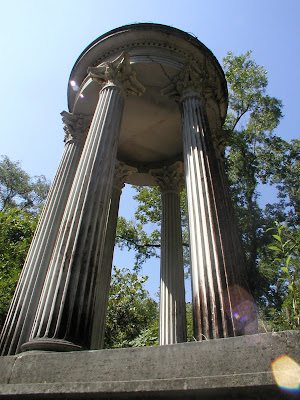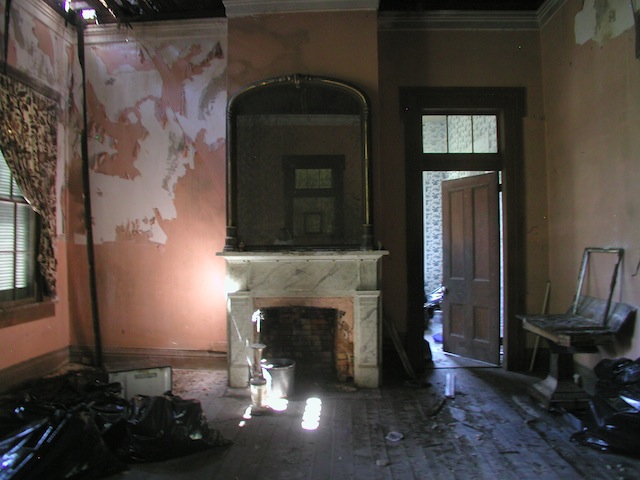Lining one of the drawers was a yellowed copy of The Natchez Democrat from 1966. I'd heard stories about errata in the paper that were so plentiful they'd practically become legend, the most famous being an unfortunately humorous headline in 1949 about five black children from Waterproof, Louisiana, who'd drowned in a local swimming hole:
FIVE WATERPROOF NEGROS DROWN
I remember hearing a story that the proofreader was so incompetent that one of the reporters on the paper decided to play a practical joke by inserting a crude remark about a local prominent citizen, using a word that rhymes with truck, into the middle of the story. He missed it. Needless to say, the proofreader and the reporter were fired.
For years The New Yorker magazine has run errata from newspaper clippings sent in by its readers. They received so many submissions from Natchez, they finally quit accepting them, deciding we had to be making it up. Nobody could be this bad!
Don't be so sure. Looking down onto that old yellowed newspaper from 1966, I scanned the top of the page. On that day the Natchez Democrat managed to misspell its own name. At the top of every page of that day's edition was Natchez (Miss.) Democrte.
One of the other stories I'd heard about was a poem that a Natchezian had written, which was a spoof on a story that had appeared in the paper. It, too, was submitted to The New Yorker, and got published. I looked high and low for the poem, and not knowing who had written it, had had no luck finding it.
Then this past weekend, it practically fell right into my lap. I attended the Natchez Literary Festival and went to listen to former Natchezian Mr. Lewis Lord, who gave the keynote address.
Mr. Lord, a journalist and historian, grew up in Natchez, and began his -- pardon the expression -- storied career on the staff of Natchez High School's school newspaper, Echoes. For years he was a journalist and historian with United Press International as Southern division news manager in Atlanta, Georgia, and later with US News & World Report in Washington, DC, as news executive and writer of cover stories on historical topics. His articles also appear in Reader's Digest, Portrait of America, and Annual Editions: American History.
Imagine my surprise when Mr. Lord started telling the story of the famous poem. I met him after the conference and told him I'd been trying to find it just last week. He very kindly sent me the portion of his address where he talks about the poem and has given me permission to use it as I like. So, that being said, I've decided to simply reprint it for my readers.
Many thanks to Mr. Lord for your kind contribution to my blog. Mr. Lord's address:
One spring day at the end of my junior year – several months after I joined the Echoes – my mother spotted a “Help Wanted” ad in the Natchez Times, the afternoon daily that existed for about a dozen years. The Times itself was seeking help. It wanted a proofreader.
Back then, people would have told you that both Natchez newspapers – the Democrat as well as the Times – needed proofreaders, rather desperately, in fact. Both had enormous problems with their ancient Linotypes, the 19th-Century machines that clanked out the metal type that formed the pages.
Here’s how they were supposed to work: A Linotype operator would hit a letter on the keyboard, and a sliver of metal bearing that letter would fall into place in a tray. A line of letters would become a line of type.
The keyboards were nothing like the keyboards of today. Vertically down the middle were six letters – E T A O I N (That spells Etaion) -- flanked on the right by six more letters – S H R D L U (Shrdlu) – and another six – C M F W Y P (pronounced Cm-fwyp).
Every few minutes a Linotype operator would run his finger down the keyboard to make sure all the letters were falling into place. He would do E T A O I N first, then S H R D L U, and do C M F W Y P two times.
He was supposed to examine the line of type he created -- a line that said “Etaoin Shrdlu Cmfwyp Cmfwyp” -- and then toss it into a bucket to be melted down the next day. But with astonishing frequency the line would somehow show up in print. Indeed no issue of the Natchez Democrat seemed complete without a half-dozen “etaoin shrdlu cm-fwyp cm-fwyps.”
Complaints were common. But my buddy Eddie and I relished the marvelous gibberish. Eddie – he’s now Dr. Edward P. Harris, professor emeritus of German literature at the University of Cincinnati – was the Echoes humor editor. Every week he wrote a column titled “Cmfwyp Cmfwyp by Etaoin Shrdlu.”
Even more wondrous was what happened when certain letters ceased to fall. For example, here as best I can tell, is what the society editor of the Natchez Democrat intended to say in a story about a fifties era bridal party:
“Mrs. Richard Feltus and Mrs. W.T. Mallory entertained yesterday at a tea shower. They feted Miss Barbara Steitenroth who is engaged to be married. The party took place at the Mallory home on Highway 61 north.
“Arrangements of white Dutch roses were used for decoration. The tea table was covered with a white imported linen cloth and centered with white flowers which were offset with lighted white candles in silver holders.”
Now the next line is missing. My guess is it said “the bride-to-be wore.” And then the story was supposed to say “a white silk frock designed on slim lines and complemented with black patent accessories. The corsage, a gift of the hostesses, was of white bridal blooms.
“Guests included a limited group of close friends.”
That’s how the story should have read. The first paragraph in fact came out okay. But from there on, certain letters as well as an entire line failed to appear. And here’s what greeted the next morning’s readers –
“Mrs. Richard Feltus and Mrs. W.T. Mallory entertained yesterday at a tea shower. They feted Miss Barbara Steitenroth who is engaged to be married. The party took place at the Mallory home on Highway 61 north.”
And now the L’s and R’s and an occasional T disappear, except for two R’s that crop up where there should be a C.
“Aangements of white Dutch es wee used fo decoation. The tea tabe was coveed with a white impoted inen coth and centeed the white fowes whirh wee offset with ighted white randes in sive hodes.
and white sik fock designed on sim ines and compemented with back patent accessoies. he cosage, a gift of the hostesses, was of white bida booms.
Guests incuded a imited goup of cose fiends.”
The New Yorker magazine, in its October 5, 1957, edition, printed that story precisely as it appeared in the Natchez Democrat. Below the story the New Yorker placed a poem penned by a lady in Natchez. Here’s what Jane Stubbs wrote:
Oh, I woud I wee a cose, cose fiend,
That these ovey things I might have seen:
The tea tabe centeed with fowes white
Offset with ighted white randes bight,
And coveed with inen coth impoted--
Suey on these I would have doted!
The sive hodes and the eses Dutch
To the decoation added much;
But the pettiest sight in those chaming ooms
Was he white sik fock and he bida booms.
So we were saying the Natchez Times wanted a part-time proofreader. My mother saw the want ad, told me to get in the car, and she drove to the Times office in the old building that still stands on the northwest corner of Commerce and State Streets. We walked in, and Mama said, “Lewis can be your proofreader.” And they hired me.
Incidentally, my great, great grandfather Major Thomas Grafton, was editor of The Natchez Democrat in the 1890s.
In this photo he is shown with several copies of the newspaper. He spearheaded several efforts to promote Natchez as a place to visit in the late 19th and early 20th centuries. The publications featured photographs of some of Natchez's antebellum homes. It was his granddaughter -- my great aunt -- Katherine Miller who followed in his footsteps as one of the principal founders of the Natchez Pilgrimage in 1932.
You can read one of the pieces he wrote about Natchez here.
I got my very first writing job at The Natchez Democrat in the late 1970s under publishers Warren and Martha Koon. I learned the embarrassment of spelling errors, firsthand, when without any knowledge of Latin, I spelled the abbreviation for "et cetera" thusly: ect. Not once, but several times.
My niece, Grafton Pritchartt, also got her first taste of journalism at the Democrat when she interned for them between semesters at Ole Miss a few years ago.
I sincerely hope there are no errors in this blog post, but if there are, they are mine. And I'm damned proud to be carrying on the torch of errata for our beloved town.































